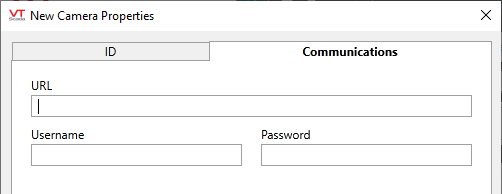Camera Tag
Before displaying a camera’s image feed on a page, you must create a connection to the camera. As with all I/O, this is the job of a tag.
Create a Camera tag for each camera that you intend to monitor. Each must be accessible on your network using a URL (uniform resource locator). Note that the video feed must be provided as a motion JPEG.
Limits:
Camera limits and VTScada to camera connection sharing are done on a per-VTScada server / thick client basis. If two thick clients connect to a camera, they make separate connections and enforce limits separately. Any limit on a thin client refers to the case when a VTScada Internet Server's local user-interface (the thick client) and one or more thin clients connected to that server, are viewing the same camera feed.
-
Where a specific camera is being viewed multiple times simultaneously (for example, on a thick client and one or more thin clients) there is no limit. VTScada makes a single connection to the camera.
-
Up to 15 connections will be made to a single host (or more specifically a scheme + host + port combination). This limit would apply where the camera streams come from a single source, such as a Network Video Recorder.
-
Where the streams are from unique sources, such as individual camera IP addresses or host names, no limits are applied to the number of unique streams retrieved by VTScada.
The ID tab of every tag includes the same common elements: Name, Area, Description, and Help ID.
Name:
Uniquely identifies each tag in the application. If the tag is a child of another, the parent names will be displayed in a separate area before the name field.
You may right-click on the tag's name to add or remove a conditional start expression.
Area
The area field is used to group similar tags together. By defining an area, you make it possible to:
- Filter for particular tag groups when searching in the tag browser
- Link dial-out alarm rosters to Alarm tags having a particular area
- Limit the number of tags loaded upon startup.
- Filter the alarm display to show only certain areas.
- Filter tag selection by area when building reports
When working with Parent-Child tag structures, the area property of all child tags will automatically match the configured area of a parent. Naturally, you can change any tag's area as required. In the case of a child tag, the field background will turn yellow to indicate that you have applied an override. (Orange in the case of user-defined types. Refer to Configuration Field Colors)
To use the area field effectively, you might consider setting the same Area for each I/O driver and its related I/O tags to group all the tags representing the equipment processes installed at each I/O device. You might also consider naming the Area property for the physical location of the tag (i.e. a station or name of a landmark near the location of the I/O device). For serial port or Roster tags, you might configure the Area property according to the purpose of each tag, such as System or Communications.
You may define as many areas as you wish and you may leave the area blank for some tags (note that for Modem tags that are to be used with the Alarm Notification System, it is actually required that the area field be left blank).
To define a new area, type the name in the field. It will immediately be added. To use an existing area, use the drop-down list feature. Re-typing an existing area name is not recommended since a typo or misspelling will result in a second area being created.
There is no tool to remove an area name from VTScada since such a tool is unnecessary. An area definition will exist as long as any tag uses it and will stop existing when no tag uses it (following the next re-start).
Description
Tag names tend to be brief. The description field provides a way to give each tag a human-friendly note describing its purpose. While not mandatory, the description is highly recommended.
Tag descriptions are displayed in the tag browser, in the list of tags to be selected for a report and also on-screen when the operator holds the pointer over the tag’s widget. For installations that use the Alarm Notification System, the description will be spoken when identifying the tag that caused the alarm.
The description field will store up to 65,500 characters, but this will exceed the practical limits of what can be displayed on-screen.
This note is relevant only to those with a multilingual user interface:
When editing any textual parameter (description, area, engineering units...) always work in the phrase editor. Any changes made directly to the textual parameter will result in a new phrase being created rather than the existing phrase being changed.
In a unilingual application this makes no difference, but in a multilingual application it is regarded as poor practice.
Help Search Key
Used only by those who have created their own CHM-format context sensitive help files to accompany their application.
Camera tag properties - Communications tab

URL
The address where the camera can be found. This must start with "http://" or "https://". Note that the feed must be provided as a motion JPEG.
Username and Password
If your camera is secured, provide the username and password as assigned. Configure these only if required by your system.
The following widgets are available to display information about your tags:
